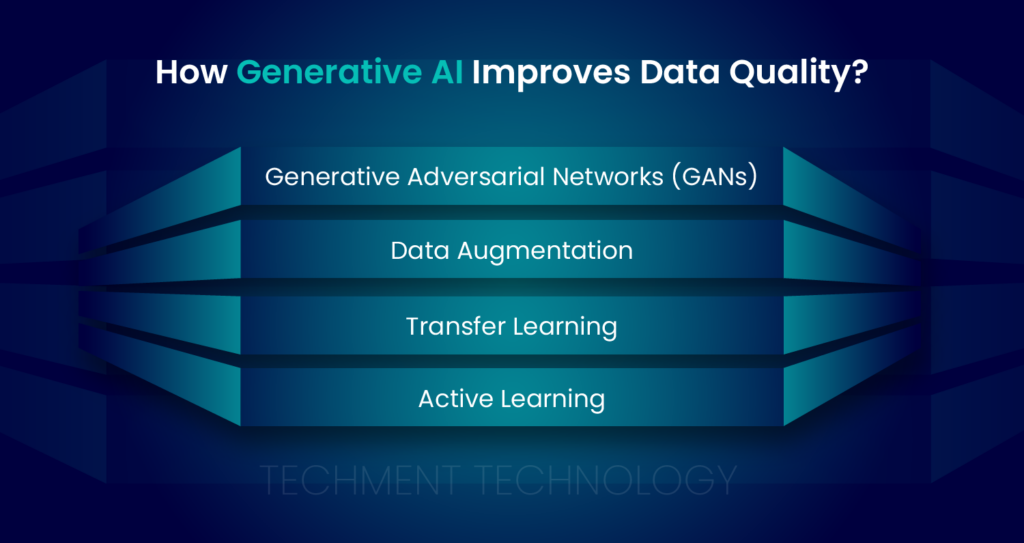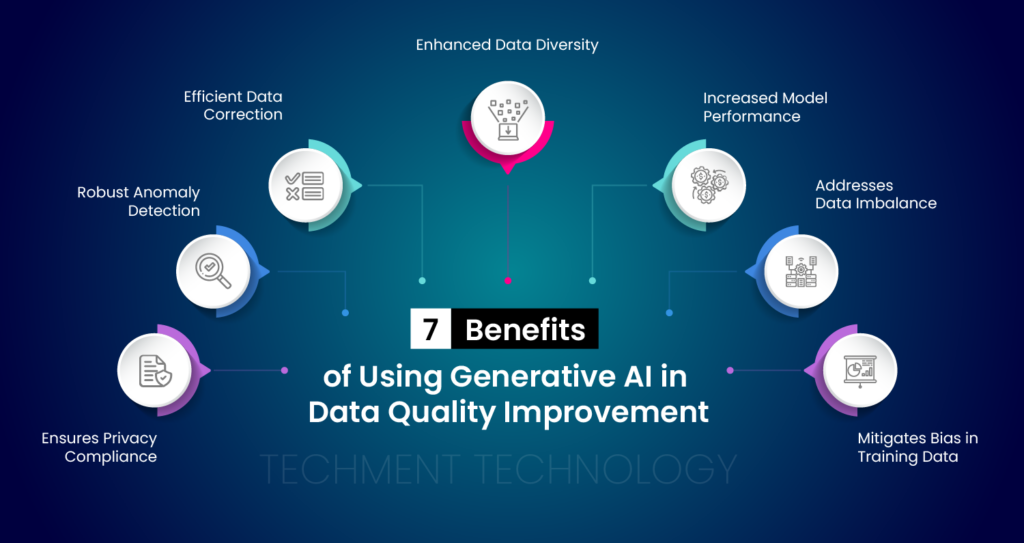Data integrity isn’t a luxury; it’s necessary for organizations striving to stay competitive and relevant in an ever-evolving market.
High-quality data catalyzes innovation within organizations, accelerating progress and fostering a culture of trust. Enhancing data quality instills confidence in decision-making processes and empowers teams to explore new ideas and opportunities with certainty. It also forms a strong foundation for providing reliable data engineering solutions.
In essence, the positive impact of data quality reverberates throughout the organization, fostering a climate of trust, collaboration, and innovation. Today, Generative AI has become omnipresent in various data engineering endeavors and a silent partner in success. Generative AI models can handle vast and diverse collections of unorganized data while simultaneously accomplishing multiple tasks.
The deep learning models, used in Generative AI, uses neural networks and statistical quality control models to clean data and perform data validation. This idea has great potential to reduce workload and improve performance as developers and business users do not need to create many data rules to identify data quality problems because deep learning algorithms will automatically learn data patterns through training datasets.
Hence, Generative AI seems to be a promising approach in enhancing data quality which potentially solves many big data challenges and helps in developing various data engineering solutions effectively. Here are certain ways that explain how generative AI contributes to improving data quality.
How does the Use of Generative AI in Data Quality Contribute to Enhancing Data Integrity?
Whether through data synthesis, anomaly detection, or predictive analytics, generative AI techniques have proven valuable in identifying and rectifying errors, filling in missing data points, and uncovering hidden patterns within vast and complex datasets. Here are some ways through which Generative AI enhances data quality:

1. Data Augmentation: Data augmentation is a technique used to generate new data from existing data. This technique trains new machine-learning models during the initial training phase. The process involves minor alterations to the original dataset to increase its size artificially. In today’s digital age, generative artificial intelligence (AI) solutions are increasingly utilized to achieve high-quality and fast data augmentation in various industries.
Data augmentation artificially generates new data from existing data to train new machine learning (ML) models for initial training. Data augmentation artificially increases the dataset by making small changes to the original data. Generative AI uses this process to improve data quality in various industries.
- Data augmentation is a valuable technique that addresses overfitting and enhances the generalization of models by exposing them to a broader range of examples.
- By expanding the range of data instances, data augmentation generates new samples incorporating slight modifications.
- For instance, in a medical imaging application where X-ray images are utilized for diagnosing conditions like bone fractures, generative AI can augment the dataset by generating variations of X-ray images. These variations encompass different angles, lighting conditions, and minor distortions.
- Such an augmented dataset can effectively improve the accuracy of an image classification model in detecting inconsistencies. This is due to the model’s increased capability to handle diverse image characteristics, thus making it more robust.
2. Generative Adversarial Networks (GANs): This is a class of machine learning consisting of two neural networks- generator and discriminator, where the former functions to generate synthetic data and later distinguishes between the two data to create more realistic synthetic samples.
This critical discriminator procedure mimics accurate data distribution, enhances training, and addresses data scarcity, thus enhancing data quality.
3. Transfer Learning: Transfer learning, a widely employed machine learning technique, involves using a pre-trained model on a new problem. Through transfer learning, machines leverage knowledge acquired from a previous task to enhance their ability to generalize and adapt to new scenarios.
- The knowledge gained from a larger dataset during pre-training enables the enhancement of data quality by facilitating the creation of more effective data representations.
As the model can generalize and adapt to new tasks, it also contributes to an increased diversity of data.
4. Active Learning: Active learning is a subset of machine learning that involves a learning algorithm engaging with a user to obtain labeled data. Through this interactive process, the algorithm proactively chooses which examples to label next from a pool of unlabeled data. The underlying principle behind the active learner algorithm is the belief that a machine learning algorithm has the potential to achieve higher accuracy even with fewer training labels if it can select the data it learns from.
This method increases the effectiveness of data model initialization through outlier detection algorithms and assists human experts in the quality assessment workflow.
By harnessing generative AI’s capabilities, organizations can significantly improve data accuracy, completeness, and consistency. Generative AI offers a powerful solution for effectively addressing data quality challenges by leveraging pre-trained models, extracting meaningful features, and fine-tuning for specific tasks.
Benefits of Using Generative AI in Data Quality Improvement Over Traditional Methods
Before the widespread adoption of AI, traditional methods were used to enhance data quality and variety. However, these methods had their limitations. The introduction of generative AI has revolutionized this landscape by eliminating those limitations and offering numerous advantages.

Generative AI’s Evolving Role in Shaping Data Engineering Beyond Data Quality
Data analytics heavily relies on high-quality data for businesses. By employing Generative AI, data quality can be significantly improved as it provides alternative approaches to enhance consistency, uniqueness, and completeness. Additionally, Generative AI can recommend suitable tools for handling vast datasets and simplifying data processing rules. The fusion of Generative AI and data quality management offers enduring benefits and has the potential to shape the future trajectory of data quality through advancements in artificial intelligence.
By utilizing the potential of generative AI, companies can explore fresh opportunities for making decisions based on data, enhance the performance of models, and streamline the processes involved in managing data. As the field of generative AI progresses further, its capacity to transform data quality practices is bound to expand.
At Techment, our generative AI services are fueled by extensive proficiency and relentless innovation, enabling us to provide customized solutions. We are widening our spectrum in Generative AI by testing its application in various use cases.
For knowing more about our capabilities in AI and other technologies, connect with our resident architects.
 All Posts
All Posts